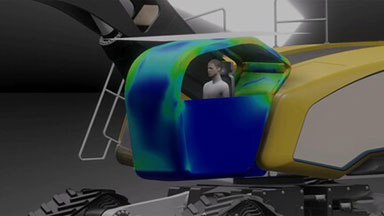Aras Thinks Big about Digital Transformation by Focusing on Process
Configuration management, system thinking and sustainable transformation guide company’s expansion.
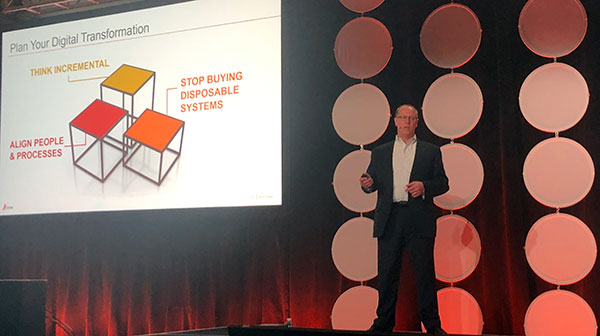
Aras CEO Peter Schroer explains the importance of people and processes to digital transformation, in addition to technology, at ACE 2019.
Latest News
April 23, 2019
“Most digital transformation projects are failing,” said Aras CEO and Founder Peter Schroer at the Aras Community Experience (ACE) 2019 in Phoenix last week. That’s a sobering way for someone who sells software intended to support digital transformation to begin a keynote presentation.
On the flip side of that coin, of course, is the solution to those failures. Being part of that solution means getting a piece of a $1.7 trillion pie. That’s how much IDC predicts will be spent on digital transformation worldwide by the end of this year, a 42% increase from 2017. Schroer believes the “open, flexible, scalable and upgradeable” Aras PLM Platform is a big part of the solution, and investors apparently agree. The company has announced more than $110 million in investments from the likes of Goldman Sachs, Silver Lake Kraftwerk and GE Ventures over the last few years.
“The interesting thing though, is there seems to be a compelling need to solve this problem, and people keep trying,” Schroer deadpanned from the stage. “I’m glad you’re all persistent.”
For many companies, that “compelling need” comes down to survival—hence the persistence. Company leaders know they need to do business differently to avoid being disrupted by competitors. What they don’t always know is where to start or how to get there, so they reach out to their employees—IT people, engineers and operations—all of whom have different ideas on how to enable digital transformation. The end result is too often division instead of cooperation. For most companies, digital transformation success doesn't stem from a top-down or bottom-up approach; it’s a collaborative effort.
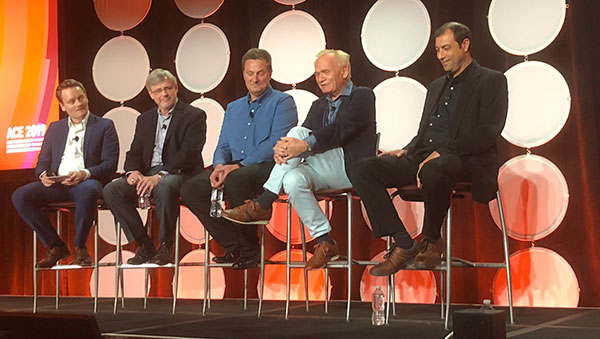
“The focus has been on the cool stuff, not PLM (product lifecycle management) and configuration management,” said Schroer. “It’s not about the cool tech, it’s about working with teams—aligning, prioritizing—it’s a cultural fit as much as it is a software fit. The key is being ready for tomorrow. How do I plan for what comes next?”
A Culture of Change
During ACE 2019, Schroer and presenters from Microsoft, GM, Sandia National Laboratories, Huntington Ingalls, Anderson Windows and others made the case that digital transformation can succeed with the right goals, the right processes and the right people.
“Our goal from a PLM-centric viewpoint is faster development of better, safer products,” Schroer said. “If the goal is to drive more profit, that’s a different kind of goal than to make safer products faster.”
Sometimes the goal is readily apparent. Four years ago at Microsoft, as cloud usage was exploding and product roadmaps included new hardware that would shake up the industry, such as the Microsoft Surface “we new right away our current systems and processes were never going to be able to support those models,” said Boris Cononetz, Jr., director of PLM and product compliance systems at Microsoft. “We knew we had to do something different.”
Cononetz said people and processes were as important as the technology when they began their “PLM journey,” as he called it. “Looking back … what happened was we went through the whole process, made this executive pitch, took it all the way up to the senior executives. Everyone agreed and then they said ‘Good we’re done, you guys go implement it.’”
He had to explain to the stakeholders that they would be needed on a continuous basis because processes would need to change that would affect the business. “This became very important, because they became our champions to communicate how and why we’re making changes.”
Sherilyn Stalker, PLM Process Leader at Anderson Windows, shared one way her team helped executives appreciate the challenges of their previous PLM system to get them onboard for a new implementation. They used a GoPro camera over an engineer’s shoulder to record, in real-time, the steps required to make a change request. She then showed the video to executives.
“As we’re playing the video, one of the executives asked ‘Are you telling me, this is what our engineers are doing every time they want to make a change request?’ It just took that video to convince our stakeholders of what a new PLM system could bring to Anderson,” she said.
System Thinking
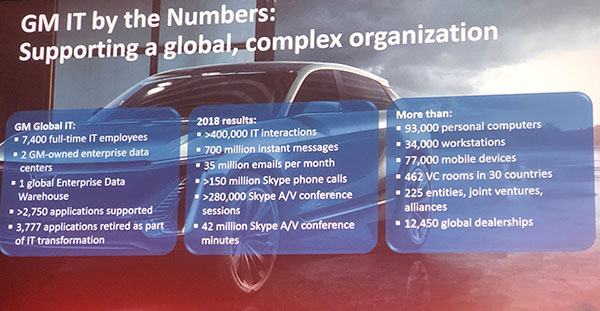
Implementing PLM is not unlike engineering a system, where engineers from different disciplines have to understand how changing one feature on what part could affect other parts of the system as a whole—only with PLM the system is the entire lifecycle of the product.
Take GM for example. The company has a complex engineering change management process and a legacy system it needs to replace. It’s working with Aras to do that and enable the required collaboration.
“We need to get a cross-functional team to look at changes engineers make,” said Peter Swartz, the IT executive at GM responsible for software development activities in support of product engineering. “There may be implications to cost, we need to make sure the suppliers are able to manage a change, we need to make sure the plants can do the tooling and manufacture it. Any changes we propose require collaboration to evaluate that.”
GM has been working on the new system for about two years and has already gone live with about 5,000 engineers using its new change management system.
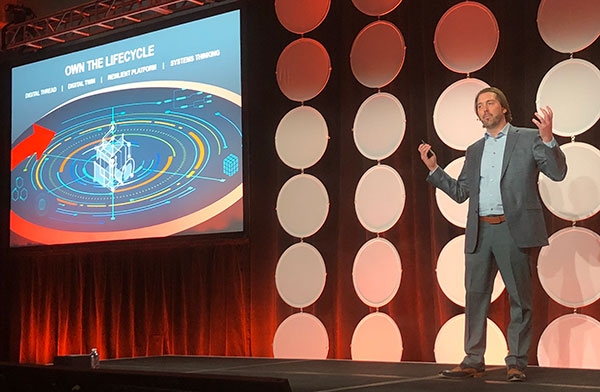
Rob McAveney, Aras CTO, presents on the company’s vision for the future and how customers are influencing that.
Now the challenge for GM and others who have made that first step is to keep up the momentum. Schroer said Aras recommends an incremental rollout thought process, rather than trying to do everything at once. The problem with a big reveal is that by the time the system has buy-in and is ready for production, the business has already changed. That's why Schroer says sustainable transformation is key, and that relies on people and processes in addition to technology.
“We’ve reached the place with IT technology, where it’s getting kind of easy,” said Schroer during an onstage chat with Joseph Anderson from the Institute for Process Excellence (IpX). Aras and IpX recently announced a partnership. “I really have a feeling now that we’re at this stage where we’re able to deliver on the platform … that’s not the bottleneck. The bottleneck is how do we get everyone on board, how do we get management aligned and keep the spirit and momentum of the project to get through phase 1?”
More Aras Coverage
Subscribe to our FREE magazine, FREE email newsletters or both!
Latest News
About the Author
Jamie Gooch is the former editorial director of Digital Engineering.
Follow DE





